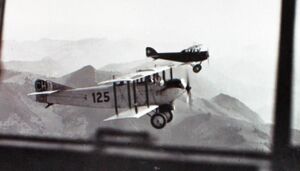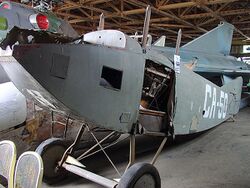Engineering:Caudron C.59
| C.59 | |
|---|---|

| |
| A C.59 (foreground) in flight with a Häfeli DH-5 | |
| Role | Multi-purpose aircraft |
| Manufacturer | Caudron |
| First flight | August 1921 |
| Introduction | 1922 |
| Primary users | French Air Force Bulgarian Air Force Turkish Air Force Finnish Air Force |
| Produced | 1922–1924 |
| Number built | 1,800+ |
| Variants | Caudron C.60 |
The Caudron C.59 was a France , two-seat biplane with a single engine and a canvas-covered fuselage, produced between 1922 and 1924. Suitable for a variety of roles, more than 1,800 Caudron C.59s were manufactured.
Operational history
The Caudron C.59 was used in a variety of countries, including: France, Bulgaria, China , Finland , Turkey and in the Spanish Civil War.
Finland
The Finnish Air Force purchased three Caudron C.59s from France in 1923. The aircraft first carried the air force designation codes 2E3-2E5 and from 1927 on CA-48 – CA-50. The manufacturing numbers of the aircraft were 5407–5409. The aircraft were equipped with wheel landing gear, but at least one aircraft (2E3) was fitted with floats. The aircraft were accepted into service on March 8, 1923, and the last one was taken out of service in 1931.
Variants
- C.59
- Original design.
- 59/2
- Fitted with 230 hp (170 kW) Lorraine 7Ma Mizar radial engine.
- C.77
- Single-seat basic trainer version; intended for 1923 ET.1 competition[1]
- C.320
- c.1932, Original C.59s but refitted with 250 hp (190 kW) Renault 9A 9-cylinder radial engine. Some later returned to their original Hispano engines.[2]
Survivors
Päijänne Tavastia Aviation Museum in Asikkala, Finland has one Caudron C.59 in storage.[3]
Operators
 Argentina
Argentina
 Brazil
Brazil
 Bulgaria
Bulgaria
 France
France
- French Air Force
- French Navy
 Finland
Finland
 Portugal
Portugal
 Romania
Romania
 Spain
Spain
 Spanish State
Spanish State
 Turkey
Turkey
 Venezuela
Venezuela
Specifications (C.59)
Data from Jane's all the World's Aircraft 1928,[5] Suomen ilmavoimien lentokoneet[6]
General characteristics
- Crew: 2
- Length: 7.8 m (25 ft 7 in)
- Wingspan: 10.24 m (33 ft 7 in)
- Height: 2.9 m (9 ft 6 in)
- Wing area: 26 m2 (280 sq ft)
- Empty weight: 700 kg (1,543 lb)
- Gross weight: 988 kg (2,178 lb)
- Powerplant: 1 × Hispano-Suiza 8Ab V-8 water-cooled piston engine, 130 kW (180 hp)
- Propellers: 2-bladed wooden fixed pitch propeller
Performance
- Maximum speed: 180 km/h (110 mph, 97 kn)
- Endurance: 3 hours 30 minutes
- Wing loading: 38.5 kg/m2 (7.9 lb/sq ft)
- Power/mass: 0.13476 kW/kg (0.08197 hp/lb)
See also
Related lists
- List of interwar military aircraft
- List of aircraft of the Spanish Republican Air Force
References
- ↑ "Caudron designations". 7 April 2010. https://www.secretprojects.co.uk/forum/index.php?topic=9745.0.
- ↑ Hauet, André (2001). Les Avions Caudrons. 1. Outreau: Lela Presse. pp. 241. ISBN 2 914017-08-1.
- ↑ Ogden, Bob (2009). Aviation Museums and Collections of Mainland Europe. Air Britain (Historians) Ltd. p. 84. ISBN 978-0-85130-418-2.
- ↑ "República - Armas - Otros aviones" (in es). http://www.sbhac.net/Republica/Fuerzas/Armas/AvOtros/AvOtros.htm.
- ↑ Grey, C.G., ed (1928). Jane's all the World's Aircraft 1928. London: Sampson Low, Marston & company, ltd. p. 95c.
- ↑ Keskinen, Kari Stenman, Klaus Niska, Kalevi; Stenman, Kari; Niska, Klaus (1976) (in fi). Suomen ilmavoimien lentokoneet 1918–1939. Helsinki: Tietoteos.
Further reading
- Anderson, Lennart (November–December 2019). "La renaissance de l'aviation militair bulgare dans les années vingt" (in French). Avions (232): 52–66. ISSN 1243-8650.
- Stenman, Kari; Keskinen, Kalevi; Partonen, Kyösti (2005) (in fi). Suomen Ilmavoimat 1918-1927. Vol. 1. Espoo. ISBN 952-99432-2-9.
External links
 |


